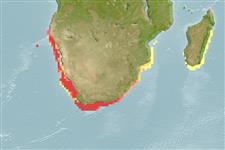Elasmobranchii (haaien en roggen) (sharks and rays) >
Carcharhiniformes (Ground sharks) >
Triakidae (Houndsharks) > Triakinae
Etymology: Mustelus: Latin for weasel, an ancient name for sharks, possibly referring to the pointed snouts, swift movements and/or rapacious feeding behavior of smaller predatory sharks [strictly not tautonymous with Squalus mustelus Linnaeus 1758 since type was designated by the ICZN]. (See ETYFish); palumbes: Latin for wood-pigeon or ring-dove, referring to its dove-gray coloration. (See ETYFish).
More on author: Smith.
Environment: milieu / climate zone / depth range / distribution range
Ecologie
marien demersaal; diepte 0 - 443 m (Ref. 5578). Subtropical; 17°S - 36°S
Southeast Atlantic: Namibia to central Natal, South Africa.
Grootte / Gewicht / Leeftijd
Maturity: Lm ? range ? - ? cm
Max length : 120 cm TL mannelijk / geslacht onbekend; (Ref. 244)
Dorsale stekels (totaal): 0; Dorsale zachte stralen (totaal): 0; Anale stekels 0; Anale zachte stralen: 0. A smoothhound with lines or scatterings of small white spots along body (Ref. 5578). Grey above, white below (Ref. 5578).
Found on the continental shelf and upper slope from the intertidal region to deeper waters over sand and gravel bottoms (Ref. 244). Feeds on crustaceans, octopi, bony fish, and fish offal (Ref. 5578). Ovoviviparous (Ref. 50449). Catch usually discarded but may be utilized in a local fishery that processes sharks into jerky (Ref. 244).
Levenscyclus en paargedrag
Maturiteit | Voortplanting | Paaien | Eieren | Fecunditeit | Larven
Ovoviviparous, embryos feed solely on yolk (Ref. 50449). 3 to 8 young per litter. Born at around 25 cm. (Ref. 5485). Distinct pairing with embrace (Ref. 205).
Compagno, L.J.V., 1984. FAO Species Catalogue. Vol. 4. Sharks of the world. An annotated and illustrated catalogue of shark species known to date. Part 2 - Carcharhiniformes. FAO Fish. Synop. 125(4/2):251-655. Rome: FAO. (Ref. 244)
Status op de Rode Lijst van het IUCN (Ref. 130435)
Gevaar voor de mens
Harmless
Gebruik door de mens
Visserij: van minder commercieel belang; sportvis: ja
Meer informatie
Leeftijd/GrootteGroeiLengte-gewichtLengte-lengteLengtefrequentiesMorfometrieMorfologieLarvenLarvale populatiedynamiekRekruteringAbundantieBRUVS
ReferentiesAquacultuurAquacultuurprofielKweeklijnenGeneticaElectrophoresesErfelijkheidZiektesVerwerkingNutrientsMassaconversie
Tools
Speciale rapporten
Download XML
Internetbronnen
Estimates based on models
Preferred temperature (Ref.
123201): 10.2 - 18, mean 12.8 °C (based on 80 cells).
Fylogenetische diversiteitsindex (Ref.
82804): PD
50 = 0.5000 [Uniqueness, from 0.5 = low to 2.0 = high].
Bayesian length-weight: a=0.00224 (0.00105 - 0.00478), b=3.14 (2.97 - 3.31), in cm total length, based on LWR estimates for this Genus-body shape (Ref.
93245).
Trofisch niveau (Ref.
69278): 3.5 ±0.5 se; based on diet studies.
Weerstandsvermogen (Ref.
120179): Zeer laag, minimale populatieverdubbelingstijd meer dan 14 jaar (Fec=4).
Fishing Vulnerability (Ref.
59153): High to very high vulnerability (72 of 100).
Nutrients (Ref.
124155): Calcium = 16.9 [4.9, 85.4] mg/100g; Iron = 0.471 [0.151, 1.782] mg/100g; Protein = 21.6 [19.3, 23.8] %; Omega3 = 0.144 [0.059, 0.331] g/100g; Selenium = 47.4 [14.1, 169.2] μg/100g; VitaminA = 6.61 [2.26, 18.61] μg/100g; Zinc = 0.615 [0.270, 1.252] mg/100g (wet weight);
